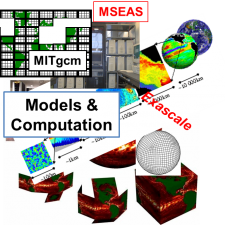Modeling the Ocean
A Formidable Challenge
The ocean is a stratified fluid on a rotating planet governed by the laws of mechanics and thermodynamics, driven from its upper surface by patterns of momentum and buoyancy fluxes. It contains a wide variety of phenomena on a plethora of space and time scales, including tides, internal gravity waves, large-scale ocean currents, and geostrophic turbulence.
Modeling the ocean is a formidable challenge. It is a turbulent fluid containing energetically active scales ranging from the global down to order 1 to 10km horizontally and some tens of meters vertically. Important scale interactions occur over the entire spectrum. The ocean also interacts with the cryosphere (land and sea-ice) and harbors life that plays a central role in biogeochemical cycles.
MSEAS and MITgcm
Two major ocean modeling activities are ongoing at MIT:
- MSEAS—the Multidisciplinary Simulation, Estimation and Assimilation System, which spearheads the application of ocean models to coastal processes in the Center for Ocean Engineering
- MITgcm—the MIT General Circulation Model is a hierarchy of models developed in MIT’s Climate Modeling Initiative for the study of global ocean circulation, ecosystems, ocean biogeochemistry, and the interaction of the ocean with the cryosphere (sea-ice and ice shelves) and the atmosphere above.





